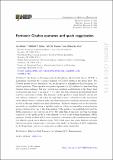Fermionic Glauber operators and quark reggeization
Author(s)
Moult, Ian; Solon, Mikhail P.; Stewart, Iain W; Vita, Gherardo
Download13130_2018_Article_7665.pdf (1.139Mb)
PUBLISHER_CC
Publisher with Creative Commons License
Creative Commons Attribution
Terms of use
Metadata
Show full item recordAbstract
We derive, in the framework of soft-collinear effective field theory (SCET), a Lagrangian describing the t-channel exchange of Glauber quarks in the Regge limit. The Glauber quarks are not dynamical, but are incorporated through non-local fermionic potential operators. These operators are power suppressed in |t|/s relative to those describing Glauber gluon exchange, but give the first non-vanishing contributions in the Regge limit to processes such as q[bar over q] → gg and q[bar over q] → γγ. They therefore represent an interesting subset of power corrections to study. The structure of the operators, which describe certain soft and collinear emissions to all orders through Wilson lines, is derived from the symmetries of the effective theory combined with constraints from power and mass dimension counting, as well as through explicit matching calculations. Lightcone singularities in the fermionic potentials are regulated using a rapidity regulator, whose corresponding renormalization group evolution gives rise to the Reggeization of the quark at the amplitude level and the BFKL equation at the cross section level. We verify this at one-loop, deriving the Regge trajectory of the quark in the 3 color channel, as well as the leading logarithmic BFKL equation. Results in the [bar over 6] and 15 color channels are obtained by the simultaneous exchange of a Glauber quark and a Glauber gluon. SCET with quark and gluon Glauber operators therefore provides a framework to systematically study the structure of QCD amplitudes in the Regge limit, and derive constraints on higher order amplitudes.
Date issued
2018-02Department
Massachusetts Institute of Technology. Center for Theoretical Physics; Massachusetts Institute of Technology. Department of PhysicsJournal
Journal of High Energy Physics
Publisher
Springer Berlin Heidelberg
Citation
Moult, Ian, et al. “Fermionic Glauber Operators and Quark Reggeization.” Journal of High Energy Physics, vol. 2018, no. 2, Feb. 2018. © 2017 Springer International Publishing AG
Version: Final published version
ISSN
1029-8479